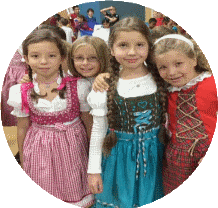Shanshan LIU
Hanban Program Chinese teacher paid by the Chinese Government
During the last three years, 2013-16, Shanshan LIU has been teaching Chinese as a second language in Kentucky. She considers it an energizing period of her life in which she has been able to further pursue and deepen her commitments to intercultural education and development. The language teaching process and cultural outreach activities involve intercultural communication, culture adaption, and an excellent understanding of English. She has improved her ability to be adaptive to a new environment, along with her communication skills among people from different cultural backgrounds, both of which are valuable for making a positive impact on the community. She has engaged the community in multiple ways such as teaching, holding cultural outreach programs and through daily engagement with the students and faculties.
She has an enthusiastic desire to deliver high-quality language teaching by using the best practices and being responsive to community centers. It is a great opportunity to extend cultural community outreach program and learn how to design the program. Designing programs to enhance the mission of the community site, making the needs and interests of students is paramount. She has forged connections to other language departments to help promote language programs at the community sites. The ESL teacher in the school expressed that: “The activity for kids in Chinese class to making wind wheel and lanterns, using chopsticks to pick up beans and fan dance are child-friendly activities. Incorporating Chinese teaching with drawing, dancing, performing and interactive activities is very innovate and entrancing.”

Working in tandem with the music teacher in Alvaton Elementary school, she presented Chinese traditional art forms, including Chinese songs, dancing, music, shadow puppet, and poetry reciting. The music teacher also used PowerPoint to show pictures of their journey to China. She performed dances that have left a lasting impression on the parents who attended the activity and instilled in students a respect and deep appreciation of Chinese art.
Cumberland Trace Elementary School hosted a celebration of the international arts night in March 2015. The Chinese teachers worked together to offer students fascinating facts about Chinese culture. Students tried on colorful Chinese costumes and practiced their skills of using ink and brush to paint panda and bamboo. They learned how to kick Chinese hacky sack very fast. Engaging, well-planned language activity for school students brought them great joy and deepened their understanding of another culture, according to the feedback from the school coordinator.
She also took part in the BG International festival, held at Circus Square Park. The Confucius Institute has for several years offered Chinese cultural experience both through dozens of booths and the Mobile Bus which provided an opportunity for the visitors exploring Chinese culture. She hosted the traditional fan dance and Taichi Kungfu booth which many visitors found fascinating. Guests enjoyed learning about Taichi fan dance. She was honored to have the opportunity to present the culture diversity that Chinese traditional art forms embodies. The Dragon boat festivals is another big event that she attended with Confucius Institute colleagues for three consecutive years, twice in Nashville and once in Louisville. Attending local affairs like this fulfills the mission of the Confucius Institute and increases the capacity to build model cultural outreach programs. 

She worked with the school gym and library teachers to maximize the resources of the community facilities. Students have dancing classes at gym where she taught them Chinese folk dances, counting actions and giving directions in Chinese. Libraries have the mandate to demonstrate inclusivity and diversity, so the introduction and teaching of Chinese cultures, customs and languages is a perfect fit. She taught Chinese games and designed activities incorporating elements of Chinese play, stories, crafts and imagination in their dynamic instruction.

In addition, she also taught classes for the university Super Saturdays program, Bowling Green Juvenile detention center, high school students’ field trip day and college students extra curriculum cultural enrichment class. The compelling reason for students to join the program is that it offers the community sites a welcoming, safe learning atmosphere where they can meet and communicate with instructors who share similar interests or heritage.
The most interesting experiences were on trips with the Chinese Culture Experience Mobile Bus of the Confucius Institute to different cities such as Central city, Owensboro and Paducah for school district students, community kids and teachers who attended the global symposium. They provide an authentic experience of Chinese culture. When she went to the Campus Point Chinese New Year’s party given by the landlord of the apartment, they told her one of the important motivations of people willing to learn another language or culture is a personal connection with one of the teachers. She was glad to be considered this personal connection to ignite students’ strong desire to gain insight into the Chinese language and heritage. 

As an elementary teacher, she taught novice beginners and interacted with young students, tailoring the class to their needs. Her goal is to teach basic vocabulary and communicative language in a friendly, playful way and contribute to ensuring the continuity of student progress in Chinese proficiency K-12. She organizes her class optimally by engaging in songs and games that aim to target the Chinese vocabulary, cultural products, practices, and perspectives. Also, the school district provides basic arts and crafts supplies and toys for creative activities, for example, to make Chinese origami. In order for students to engage in Chinese class she sometimes prepares simple snack for vocabulary lessons about fruit, vegetables, and shopping. Students learn the terms of ingredients and simulated farmer’s market shopping, followed by process words for food and eating. 

She takes age into consideration and tries her best to present the lessons in game-like fashion. She creates activities with clear language goals that engage students physically in movement, dance and games. She sometimes engages the class by introducing active Chinese circle games using
shuttlecocks, puppetry with panda figures and the Monkey King legend. Children being reluctant to leave after class is a very clear indication of student engagement. The mood of each class is often characterized by laughter, active engagement with the language, and high spirit. Students frequently express how enjoyable the Chinese classes are. Among the aspects they enjoy the most are learning calligraphy, using Chinese ink and brush to paint panda and bamboo, Chinese Taichi fan dance, preparing and tasting Chinese food, learning about the Chinese Zodiac animals. She feels her three years’ experience that created, revised and implemented learning plans will be a valuable skill set in the future.
 She is very open to questions and flexible to suggestions. It ensures ongoing communication which is imperative for the program to endure and exceedingly important for garnering enthusiastic community support. By strengthening her commitment and ongoing support to community outreach, she can link the pedagogic, linguistic and organizational skills of students and faculty with communities to promote Chinese language learning for transnational communication and connections.
She is very open to questions and flexible to suggestions. It ensures ongoing communication which is imperative for the program to endure and exceedingly important for garnering enthusiastic community support. By strengthening her commitment and ongoing support to community outreach, she can link the pedagogic, linguistic and organizational skills of students and faculty with communities to promote Chinese language learning for transnational communication and connections.
The positive impact Shanshan has had on the community through Chinese class makes a difference in the lives of students who are learning Chinese and in the lives of their parents and the community overall. It is important to have training in language pedagogy. Parents frequently express their gratitude that their children are given an opportunity to learn a new language. And they express how valuable, memorable and rewarding learning Chinese is. The sole fact that they have welcomed Chinese classes for multiple semesters in a row shows that they recognize and appreciate the value of having Chinese projects in their school. As with child language development and economic globalization, community parents voiced their wish to have their children exposed to a different language. Chinese class opens new experiences for students, and parents tend to be very supportive.
The CHF teacher exchange program provided her an opportunity to combine two things she most enjoys: language and teaching. It also matches her long-term career goal to further develop her professional teaching skills, incorporating immersion approaches in her teaching methodology, applying more effective classroom management skills, as well as awareness-raising activities. If she stays for an additional year or two, she plans to equip herself with practical ideas, techniques, and strategies to build more effective, flexible, and resourceful techniques attuned to the Chinese learning needs of her students. She will formulate a tentative vision and steps for implementation teaching plans, focusing on what can be reasonably offered. Consultations with school teachers about quality and pedagogical soundness is necessary for students and parents to continue advocating Chinese language and culture programs.






